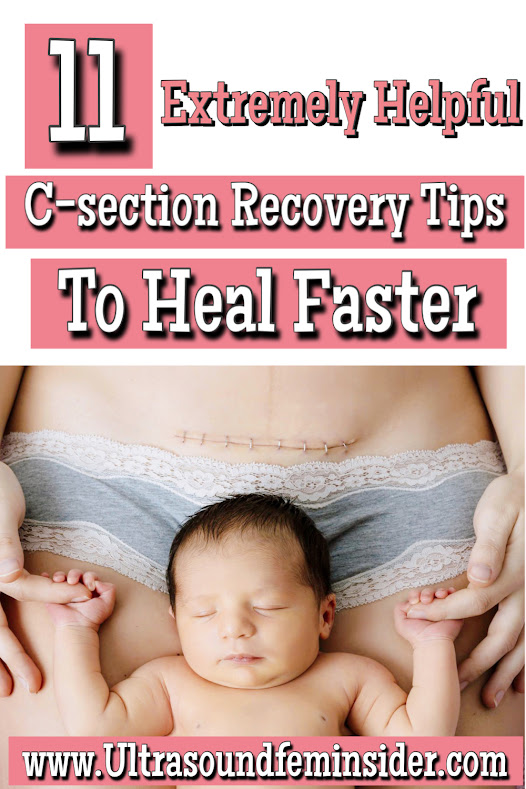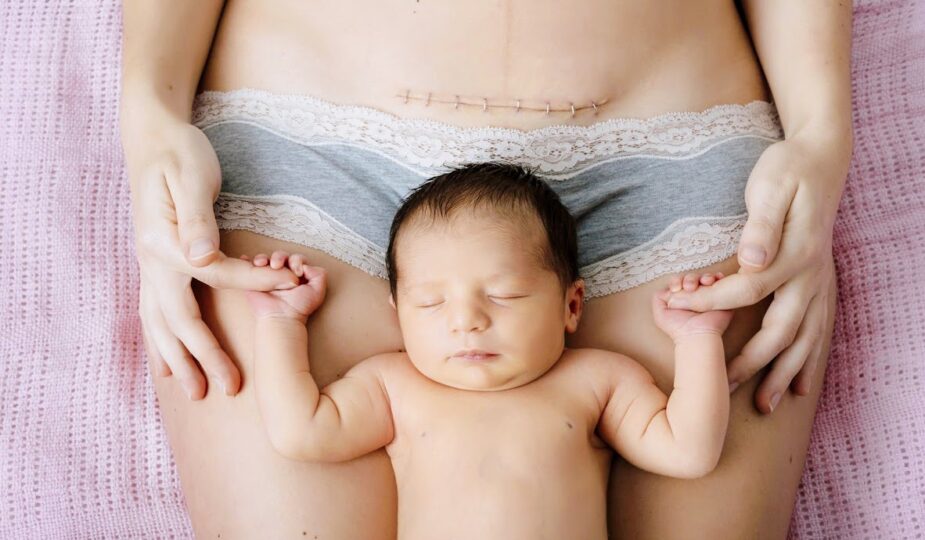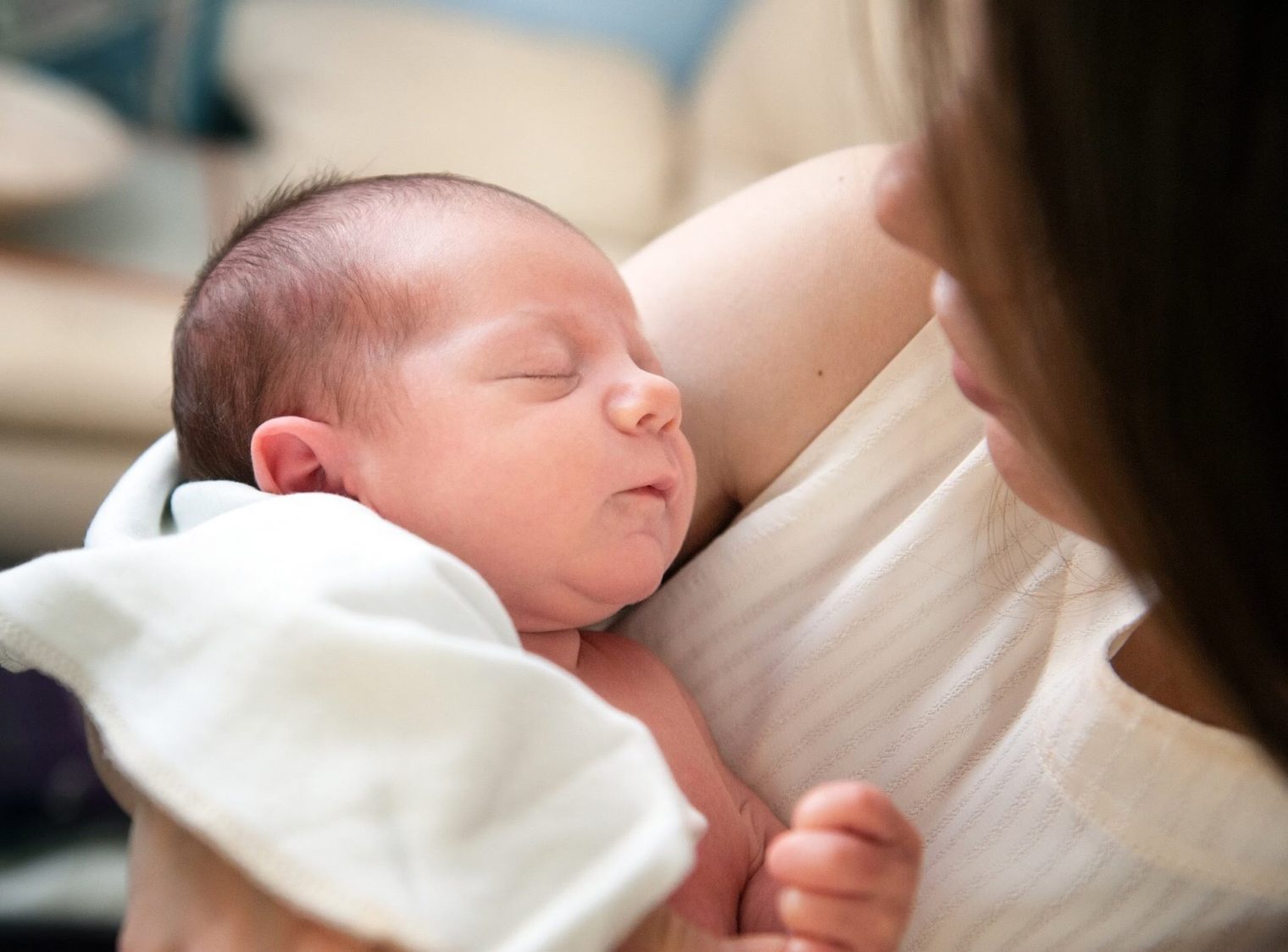Having a C-section, whether by choice or not, may be a traumatic event for any mom, especially new moms-to-be. Some physical difficulties can also arise after a c-section, therefore is important to take care of your body appropriately afterwards. When I first learned that I would need a c-section, I was terrified, I had no idea what to expect. In this article, I will discuss the top 11 C-Section Recovery Tips that will Help You to be prepared and to heal faster. Ready? Let’s begin.
Reasons why a Women Might Need a C-section?
There are several circumstances in which a C-section is advised. When there is a medical problem that prevents the mother from giving birth vaginally a C-section may be necessary. Some examples of these include the following:
- Placental complications such as placenta previa and placenta accreta are two specific examples of this condition. Placenta previa occurs when the placenta is covering the cervix completely, which prevents a vaginal delivery of the baby. Placenta accreta is an extremely uncommon condition that occurs when the placenta grows into the uterine wall and pose a higher risk of hemorrhage during delivery.
- Vaginal obstruction such as large uterine fibroids.
- A case of herpes that is currently active and put the baby at a higher risk of infection.
- Abnormal fetal position in the uterus. Meaning baby is not cephalic. Baby is breech or transverse at the time of delivery.
- Fetal Macrosomia, meaning the baby is too big at term, more than 4000 grams.
- Maternal pre-existing medical conditions such as high blood pressure or other diseases during the time of pregnancy.
During labor and delivery sometimes an emergency C-section may be necessary. The reasons may be attributed to the following:
- The inability of the cervix to dilate, also known as an arrest of dilatation.
- The condition known as stoppage of descent, condition that occurs when the baby does not descend in the pelvis despite the mother pushing.
- Concerns over the health of the mother and/or the unborn child.
How long does the discomfort following a cesarean section typically last?
After a c-section, you will require pain medication for at least 7–10 days, because your incision will feel uncomfortable and bruised for a while. It took me a full six weeks to recover and resume normal activity after mine.
First of all, Please Be Mindful of what you can and can’t do.
- A C-section is a major surgery on your abdomen that will take some time to heal from. You will have pain and won’t be able to do a lot of things. Instead of getting down, it’s best to know your limits and make plans. Some of the things a mom who had a C-section can’t do are listed below.
- Don’t pick up anything heavy. In the first few weeks after surgery, it’s very important not to lift anything heavy because it can put pressure on your incision, which can be very painful. Also, if your partner can, ask them to pick up the baby and put it in your arm while you feed it.
- Avoid the stairs. After an abdominal surgery, it can be hard to go up and down the stairs. During the first few weeks, it will be hard for you to walk, so try to stay in one place where you can rest and take care of your baby.
- It was hard for me to sit up for a few weeks after my c-section. This was one of the things that surprised me the most. I couldn’t sit up straight, and I had to ask my husband for help all the time.
- It can hurt to sneeze or cough. After a c-section, it hurts a lot to sneeze or cough, so try to avoid getting sick as much as possible. After my c-section, I got a bad cough, and it hurt so much every time I coughed.
- Sex will hurt because the wound needs 6–8 weeks to heal, and the stitches will fall out on their own as the wound heals. Even though you can have sex again after your cut has healed, the first few times will still hurt. Some moms can have pain-free sex for up to 12 to 16 months after giving birth.
- You can’t drive for at least two weeks: Your doctor will tell you not to drive for at least two weeks because you can’t put any pressure on the cut.
- Prepare your postpartum kit in advance with all the necessary items you need to care for your incision.
You can share this article by clicking the image below.

Here you have the 11 C-Section Recovery Tips to Heal Faster.
1. Get as much assistance as you possibly can.
After you bring your baby home from the hospital, you will realize that it is going to be quite exhausting since you will spend most of your time feeding and caring for the baby while also attempting to heal from the discomfort of the cesarean section. When that happens, it will feel nearly difficult to make any progress with the chores around the house.
You should make an effort to seek as much assistance as you can, such as having members of your family or friends assist you with the preparation of meals or hiring a cleaning service to assist you with the cleaning of your house during the first few weeks. If you do not have any family members or friends that are able to assist you, then you might look into hiring a doula. They are a little on the pricey side, but they may be of great assistance to you in taking care of the infant, as well as in other areas like as cleaning your house, preparing meals, and many other tasks.
2. Try to Rest Whenever you are able to.
I know it may sound almost impossible, but to heal quickly after a c-section surgery, rest is essential. That is why, among other things, the first tip is very important. During recovery and for the body to be able to use its healing power, it needs, among other things, rest.
3. Start Moving as soon as you Possibly Can After the Surgery.
In many ways, a C-section is just another type of surgical procedure. After surgery, it may change how you do some things. You shouldn’t give in to the temptation of a long nap or sleep in. In extreme cases, this might cause a blood clot to form due to a buildup of blood in the veins. You should start walking as soon as your doctor gives you the green light to avoid this. You may ease into it by walking a small distance with assistance at first, then gradually raise both the starting distance and the maximum speed. As a result, your body may resume regular functioning and the likelihood of developing any more difficulties is reduced.
Change positions and stretch out. But remember that exercises should be avoided for at least six weeks after giving birth. In any case, little exercise and stretching can put a woman back in touch with her body and her healing process.
4. Eat healthy foods.
Vitamin-rich foods are essential after a cesarean section. Because vitamins aids in tissue healing and the creation of collagen, which also helps in the formation of new cells. Vegetables such as spinach, broccoli, and fenugreek are rich in vitamin A and vitamin C, as well as calcium and iron. All of these nutrients have a role in wound healing, and it may be beneficial to consume sufficient quantities when recuperating after a cesarean section.
After a C-section, vitamin A, B1, B2, B3, C, folic acid, and vitamin B12 are the most essential vitamins. Vitamin C is an essential nutrient due to its extraordinary ability to combat bacterial infections and its capacity to speed up healing. Vitamin-rich foods include papayas, oranges, grapes, tomatoes, broccoli, melons, and strawberries. Proteins also contribute to the development of new cell tissues and the healing process. After surgery, protein-rich diets improve tissue healing and preserve muscular strength. You are permitted to consume fish, eggs, chicken, dairy products, meat, peas, and nuts.
5. Get Prepared to Deal with Constipation even Before it Starts.
It’s possible that using pain medication along with pregnancy hormones might lead to constipation. Due to the increased pressure inside the abdomen brought on by constipation, the incision might become strained. This may be very uncomfortable, therefore getting enough fiber in your diet is crucial. Many gastrointestinal problems, including bloating, diarrhea, gas, stomach discomfort, and constipation, can be alleviated by increasing your fiber intake. One more healthy routine is drinking enough of water every day. Constipation can be relieved with regular yoga practice, which also has the added benefit of calming the mind. You can also request a stool softener from your doctor.
6. Breastfeed with Support.
Breastfeeding is a physically demanding activity. If possible, try to feed your baby while sitting up straight in a chair. This position will allow you to use a breastfeeding pillow, will help to ease the pressure in your abdominal muscles, will allow to stay oxygenated and will improve your posture to avoid back pain or exhaustion for the lack of oxygen.
7. Take Good Care of your Incision.
After a C-section, it is crucial to maintain your incision healthy. Taking good care of your incision will speed up the healing process after surgery. The incision site must be kept clean and dry. Covering it may also help prevent infection. Infection can manifest itself thermally, aesthetically, and painfully. You shouldn’t ignore any of those abnormal signs of infection and should visit a doctor if you experience any of them.
Even while modern C-section incisions are far smaller than in the past, they still require careful attention to prevent infection. If you’ve had an incision made, your doctor will give you specific instructions for taking care of it, such as keeping the area dry and clean and washing it with warm, soapy water once a day.
Don’t use scented or otherwise enriched soaps if you can help it. Use a mild antibacterial soap instead.
Your doctor may use strips of tape to seal an incision. Within a week, they normally disappear on their own. Infections can develop around wounds, so it’s important to see a doctor right away if you experience any of the following symptoms: swelling, discomfort, redness, or leaking.
8. Use Pain Killers if you have to.
The healing process will be hampered if pain is not managed. Having pain might also make it difficult to care for a newborn. The medicine your doctor gives you will be safe for you to breastfeed while taking. After a C-section, most women will require pain medication for at least a few days, and sometimes much longer.
The use of an abdominal binder can be beneficial for managing chronic discomfort as well. You can get them at the hospital or buy them outside the hospital too. Wear it as often as you like if you like it, but don’t wear it in the shower.
9. Avoid Submerging your Surgery in Swimming Pool or Deep Bathtubs.
If taking long, hot baths is a regular part of your post-surgery routine for relaxation and recuperation, you should not do so for the first six weeks. Infections might develop if you take a bath before the incision has healed and the bleeding has ceased. Rather than taking baths, try showering so that your incision is not buried in water. If you’re still experiencing discomfort and finding it difficult to move about, a shower seat may be very helpful.
Zit bath: You can take a sitz bath for 10 to 15 minutes up to three times daily. You may build a sitz bath in your own bathtub by filling it with only two or three inches of warm water and sitting in it. A sitz bath will allow you to relax and soothe your vaginal region while keeping your incision dry. A sitz bath kit, which can be mounted on a toilet, is available for those who have trouble entering and exiting the tub.
10. Make sure you drink enough water.
Water aids with digestion, reduces swelling, and helps with constipation, all of which contribute to a quicker recovery and better overall health. After giving birth, it is common to have swelling because of all the fluids that are pushed into your body during labor and delivery. Swelling of the feet, legs, hands, and face might occur because the fluid has to go somewhere. Get plenty of fluids to help drain away the extra fluid. However, you should consult a doctor if the swelling is hot to the touch or uncomfortable.
11. Take care of yourself first and foremost.
Whatever form it takes, giving birth is a monumental event that puts a lot of strain on the body. Don’t forget about yourself in the midst of caring for your newborn after a C-section. Although it may feel like an eternity now, the wait is almost over.
Related Posts you might want to read!
Kick Counts During Pregnancy. How to do it and Why is Important.
All About Vaginal Discharge During Pregnancy.
25 Most Common Pregnancy Questions Answered.
Postpartum depression. Causes, symptoms and prevention.
Final Thoughts about C-Section Recovery Tips to Help You Heal Faster.
Recovery following a C-section will be unique for each woman and will depend on a variety of circumstances, including the amount of rest and assistance you can get. When you are taking care of a new baby, you will likely be sleep deprived, and everything around you may feel quite exhausting. Because of this, it is very essential to try not to become overwhelmed and instead to take things one step at a time. I hope I was able to help with these tips. Le me know in the comments below.
Zadi, XOXO
Disclaimer: The medical information on this post is for educational and entertainment use only. Under no circumstances, this information is to replace your doctor’s advice or to treat any disease. For proper care, always visit your doctor.










[…] C-Section Recovery Tips to Heal Faster. […]
[…] C-Section Recovery Tips to Heal Faster. […]
[…] C-Section Recovery Tips to Heal Faster. […]
[…] C-Section Recovery Tips to Heal Faster. […]